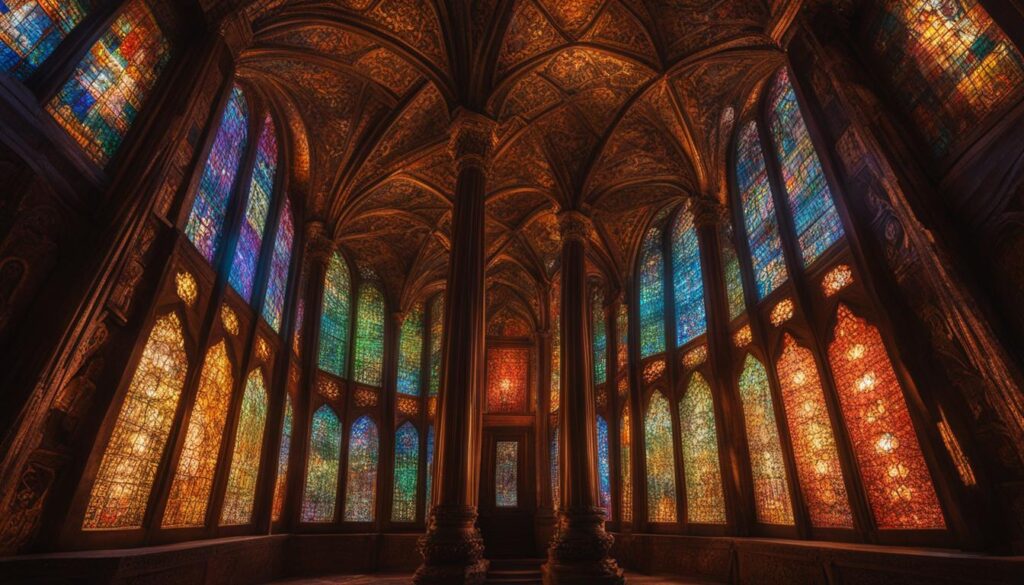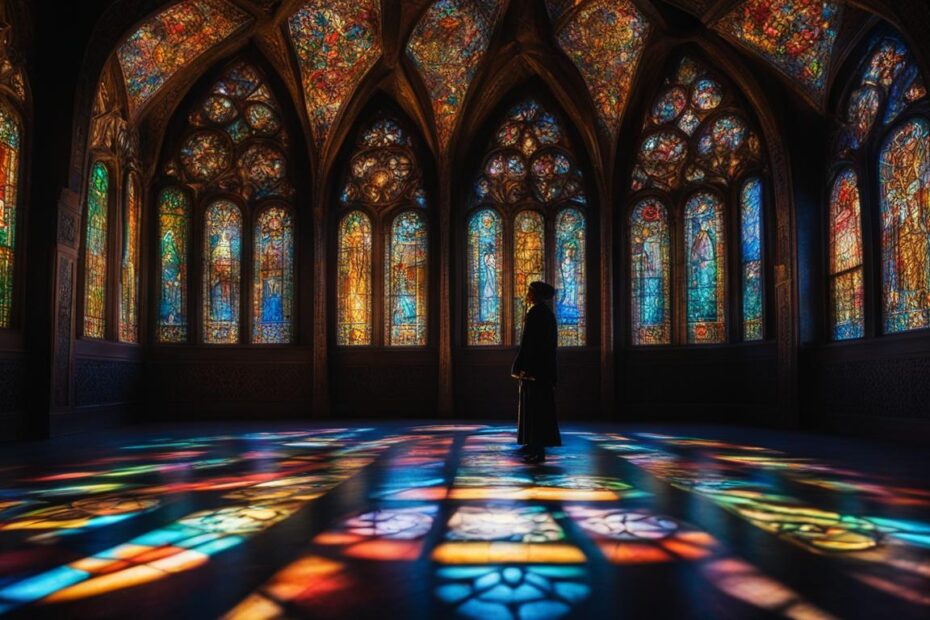Sacred Spaces have a profound impact on the human spirit, offering a sense of tranquility, solace, and connection to the divine. In this article, we will delve into the concept of Sacred Spaces, exploring their significance and the peace they offer to those who seek them. We will uncover the mystery behind their creation and the profound experiences they provide for individuals. Through a combination of poetic exploration and scholarly analysis, we will reveal the beauty and spiritual depth that can be found in these sacred environments.
Key Takeaways:
- Sacred Spaces offer tranquility, solace, and a connection to the divine.
- They hold significance and provide peace to those who seek them.
- Sacred Spaces can be created in various forms, such as spiritual retreats, sacred architecture, meditation spaces, and religious sanctuaries.
- They encompass holy sites and sacred destinations, providing peaceful and serene environments.
- Exploring and experiencing Sacred Spaces can lead to profound spiritual and transformative experiences.
The Power of Creating a Spiritual Sanctuary at Home
In today’s fast-paced world, finding moments of peace and tranquility can be challenging. However, creating a spiritual sanctuary within the comfort of your own home can provide a sacred and nurturing space for reflection and rejuvenation. Transforming different rooms into sanctuaries allows you to connect with your inner self and find solace amidst the chaos of daily life.
Consider the kitchen, a place where nourishment is prepared and shared with loved ones. By infusing this space with intention and mindfulness, you can turn it into a kitchen sanctuary. Light a candle, play soothing music, and engage in mindful cooking practices to transform this everyday chore into a sacred ritual.
The living room, traditionally a space for relaxation and gathering, can become a living room sanctuary. Decorate with soft cushions and warm colors, creating a cozy and welcoming environment. Dedicate this space to activities such as reading, journaling, or meditation, allowing yourself to unwind and connect with your inner self.

| Room | Suggested Features |
|---|---|
| Bedroom | Soft lighting, calming colors, comfortable bedding |
| Garden | Plants, flowers, a small fountain or bird feeder |
| Study | Inspiring artwork, a cozy reading nook, a sacred altar |
| Bathroom | Scented candles, relaxing bath products, soft towels |
| Closet | Organized space, calming scents, soothing colors |
| Attic | A quiet retreat, a sacred space for reflection and introspection |
By creating these sanctuaries within your home, you are honoring your soul’s cry for peace and sacredness. Each room can become a different expression of your spiritual journey, providing a sense of tranquility and divine connection. Remember, your home has the potential to be a sacred space, a chapel where you can seek solace, find inspiration, and nourish your spirit.
The Healing Power of Sacred Spaces
In the quest for healing and well-being, individuals have long sought solace in sacred spaces. These spiritual landscapes, known as therapeutic landscapes, hold a profound connection between healing, spirituality, and place. A scientific paper published in PMC explores this relationship, shedding light on the healing power of sacred spaces.
The paper focuses on two sites in Scotland, Killin and the Bield, which have a rich history of spiritual significance and healing. These places offer a space for connection, renewal, participation, and the alleviation of ailments. They provide a sanctuary for individuals to experience healing and well-being.
Through a deeper understanding of these sacred sites, we can gain insights into the human quest for healing and wholeness. The exploration of these therapeutic landscapes offers a glimpse into the profound impact that sacred spaces have on our spiritual and physical well-being.
“Sacred spaces have long been recognized as places of healing and renewal. They offer a sense of connection to something greater than ourselves and provide a space for reflection, restoration, and transformation.” – Dr. Sarah Thompson, co-author of the scientific paper.
The Healing Power of Pilgrimage in Christianity
In addition to the therapeutic landscapes discussed in the paper, pilgrimage holds a significant place in the Christian tradition. Throughout history, Christians have embarked on pilgrimages to sacred sites such as Jerusalem, Rome, and Santiago de Compostela. The act of pilgrimage is believed to bring spiritual healing and a deep connection to one’s faith.
As pilgrims embark on their journey, they leave behind their everyday lives and enter a sacred space dedicated to their spiritual growth. The physical and spiritual challenges encountered on the pilgrimage path contribute to transformative experiences and offer an opportunity for healing and renewal.
| Sacred Site | Location |
|---|---|
| Jerusalem | Israel |
| Rome | Italy |
| Santiago de Compostela | Spain |
These sacred destinations hold deep spiritual significance for Christians, offering a space for prayer, contemplation, and connection with the divine. Pilgrimage not only allows individuals to seek healing but also provides a sense of unity within the Christian community.
The healing power of sacred spaces extends beyond physical ailments. It encompasses the nourishment of the soul and the restoration of inner peace. Whether through therapeutic landscapes or the act of pilgrimage, sacred spaces offer a profound sense of connection, renewal, and well-being.
Natural Sacred Spaces: A Source of Reverence and Ritual
The concept of natural sacred spaces holds immense significance in various religious and spiritual traditions, including Hinduism and Native American religions. These spaces are believed to possess a divine presence and serve as portals for connecting with the sacred. Through rituals and practices, these natural environments become sanctified, embodying the cycle of affect that elicits reverence and spiritual connection.
In Hinduism, natural sacred spaces are deeply intertwined with the religious and mythological narratives of the faith. Mount Meru, for example, is considered a sacred mountain and represents the cosmic center of the universe in Hindu cosmology. Carved cliff temples, such as the Ellora and Elephanta caves, are revered as sacred sites where divine energies manifest. Additionally, the Ganges River, known as the sacred lifeline of Hinduism, holds immense spiritual significance and is a site of pilgrimage and ritual cleansing.
In Native American religions, natural sacred spaces are integral to the spiritual practices and cultural traditions of indigenous communities. Mountains, rivers, caves, and other natural features are regarded as manifestations of the sacred and are imbued with spiritual power. These spaces serve as focal points for ceremonies, rituals, and prayers, allowing individuals to connect with the divine forces and ancestral spirits.
| Natural Sacred Spaces in Hinduism | Natural Sacred Spaces in Native American Religions |
|---|---|
| Mount Meru | Sacred Mountains |
| Carved Cliff Temples | Rivers and Waterfalls |
| The Ganges River | Caves and Caverns |
The reverence and rituals associated with natural sacred spaces in Hinduism and Native American religions highlight the deep connection between humanity and the natural world. These spaces provide opportunities for individuals to engage in spiritual practices, commune with the divine, and seek guidance and healing. As individuals immerse themselves in these natural environments, they are reminded of the interconnectedness of all life and the need for harmony and respect for the Earth.
The Cycle of Affect: An Analysis of Natural Sacred Spaces
The cycle of affect plays a significant role in the creation and maintenance of natural sacred spaces. This cycle begins with the initial emotions and affect that individuals experience when encountering a natural feature, such as the majestic Devil’s Tower, the sacred Ganges River, or the serene Crater Lake. These powerful emotions inspire a deep connection and reverence for these natural spaces.
As individuals connect with these sacred sites, stories and myths are developed to explain their significance and capture the essence of their beauty and power. These stories, in turn, lead to the development of rituals and performances that seek to honor and restore the initial emotions and affect associated with the sacred space. For example, at Devil’s Tower, Native American tribes perform prayers and rituals to pay homage to this geological wonder and maintain its sacredness.
The cycle of affect reinforces the sanctity of natural sacred spaces and deepens the spiritual connection individuals have with these places. It highlights the interplay between emotions, stories, rituals, and the ongoing reverence for these natural features. By understanding and analyzing this cycle, we can gain a deeper appreciation for the profound impact that natural sacred spaces have on human spirituality and the quest for connection to the divine.

Table: Comparing Natural Sacred Spaces
| Natural Sacred Space | Location | Significance |
|---|---|---|
| Devil’s Tower | Wyoming, United States | A sacred site for Native American tribes, associated with creation stories and spiritual practices. |
| Ganges River | India | A holy river in Hinduism, believed to cleanse sins and provide spiritual purification to those who bathe in its sacred waters. |
| Crater Lake | Oregon, United States | A deep blue lake formed within the collapsed caldera of a volcano, considered sacred by Native American tribes and associated with spiritual significance. |
Through the cycle of affect, natural sacred spaces continue to evoke awe, reverence, and a deep connection among those who encounter them. These spaces become more than just physical landscapes; they become portals to the divine and sources of spiritual nourishment. By recognizing the power of the cycle of affect in the context of natural sacred spaces, we can appreciate the profound impact these spaces have on human spirituality and the quest for meaning and transcendence.
Natural Sacred Spaces in Hinduism: Manifestations of Divine Connection
In Hinduism, natural sacred spaces hold deep spiritual significance and are seen as manifestations of divine connection. Mount Meru, carved cliff temples, and the Ganges River are three such sacred sites that exemplify the sacred cosmology of Hinduism.

The Sacred Sites
| Sacred Site | Significance |
|---|---|
| Mount Meru | A mythical mountain considered the center of the universe and the abode of the gods. It represents spiritual ascent and enlightenment. |
| Carved Cliff Temples | Elaborately carved temples built into the sides of cliffs, symbolizing the symbiotic relationship between humans and nature. |
| Ganges River | Regarded as the holiest river in Hinduism, believed to cleanse sins and grant moksha (liberation). It represents the divine goddess Ganga. |
Hindu cosmology suggests that these sacred sites are not only physical locations but also reflections of the divine within the earthly realm. They serve as portals for spiritual connection, enabling devotees to experience a deeper sense of divinity and transcendence.
Various rituals and practices are performed at these natural sacred spaces, including prayers, offerings, and bathing in the holy river. These acts of devotion are believed to facilitate a profound connection with the divine and bring spiritual purification and blessings.
The Ganges River: A Sacred Source of Life and Cleansing
In Hinduism, the Ganges River holds immense significance as a sacred space. It is revered as a source of life and spiritual cleansing, playing a central role in religious rituals and practices. The Ganges River is believed to be the earthly manifestation of the goddess Ganga, who is worshipped for her purifying and healing powers. Hindus consider bathing in the Ganges to cleanse themselves of sins and attain spiritual purification. The river is seen as a pathway to salvation, and its waters are believed to have the ability to wash away impurities and grant spiritual liberation.

However, the sanctity of the Ganges River faces the challenge of pollution. Despite its revered status, the river is heavily polluted with industrial waste, sewage, and other contaminants. Efforts to address this pollution while maintaining the sacredness of the river have been a complex undertaking. Environmental conservation initiatives and awareness campaigns have been launched to protect the Ganges and restore its purity. The issue of pollution in the Ganges River raises important questions about the balance between spiritual beliefs and environmental responsibility.
As Hindus navigate this delicate balance, they continue to hold the Ganges River in deep reverence. The rituals and practices associated with the river remain an integral part of Hindu religious life, showcasing the unwavering faith and devotion to this sacred space. The Ganges River serves as a powerful symbol of life, purity, and spiritual connection for millions of Hindus around the world.
The Spiritual Dimensions of Sacred Spaces
Factual data highlights the importance of spirituality in Sacred Spaces and the different interpretations of spirituality. It emphasizes the interdependence, mutuality, and connection that spirituality brings to individuals. The spiritual experience is not confined to religious practices but encompasses a personal search for meaning, purpose, and overall well-being. The understanding of spirituality extends beyond the boundaries of religion and includes ethical beliefs, compassion, love, and a sense of connection to something greater, such as nature. The spiritual dimensions of Sacred Spaces contribute to a sense of wholeness and integration of the body, mind, and spirit.
The Essence of Person-Centered Spirituality
Person-centered spirituality recognizes that each individual’s spiritual journey is unique, and spirituality is deeply personal and subjective. It emphasizes the importance of self-discovery, self-reflection, and self-expression in the quest for spiritual fulfillment. Person-centered spirituality encourages individuals to explore and cultivate their own beliefs, values, and practices, fostering a sense of autonomy and authenticity in their spiritual lives. It acknowledges that spirituality is a dynamic and evolving aspect of human experience, shaped by personal growth, life experiences, and the search for meaning and purpose.
Connection and Well-being: The Power of Sacred Spaces
The spiritual dimensions of Sacred Spaces are intricately tied to the concept of connection. These spaces provide a tangible and experiential connection to something larger than oneself, whether it be a higher power, the natural world, or the collective human experience. The experience of connection in Sacred Spaces fosters a sense of belonging, purpose, and transcendence, enhancing overall well-being. Research suggests that individuals who cultivate a strong sense of connection through spirituality experience greater psychological resilience, lower levels of stress, and increased life satisfaction.
Creating Sacred Spaces: A Personal and Collective Journey
Creating and nurturing Sacred Spaces is both a personal and collective journey. Individuals can cultivate their own sacred spaces within their homes, workplaces, or natural surroundings, infusing these spaces with intention, meaning, and spiritual significance. On a collective level, communities can come together to create and maintain sacred spaces that serve as places of worship, meditation, and reflection. The process of creating Sacred Spaces is an ongoing practice that requires mindfulness, intentionality, and a deep understanding of the spiritual needs and aspirations of individuals and communities.

The Healing Power of Connection to Sacred Places
Sacred Spaces have a profound healing power, offering individuals a deep sense of connection, restoration, and well-being. The experience of being in these sacred places goes beyond the physical environment; it taps into the spiritual essence of the individual, providing solace and rejuvenation. The connection formed between individuals and these sacred spaces creates a sanctuary for the soul, allowing for reflection, healing, and the transcendence of everyday challenges.
Research has shown that the healing power of sacred places lies in the deep connection individuals experience when in these spaces. The sense of connection fosters a profound sense of well-being, both emotionally and physically. Being in a sacred space allows individuals to find meaning and purpose, away from the distractions of daily life. It provides a space for introspection, self-reflection, and inner healing.
“The connection to Sacred Spaces helps individuals find meaning, purpose, and a sense of transcendence beyond the challenges of everyday life.”
Place-based spiritual landscapes offer a unique opportunity for individuals to reconnect with themselves, their spirituality, and the world around them. These sacred places have a transformative effect on individuals, facilitating growth, healing, and self-discovery. The power of connection to sacred places lies in their ability to provide a sanctuary for the soul and a source of rejuvenation.
In conclusion, the healing power of connection to sacred places cannot be underestimated. These sacred spaces offer individuals a deep sense of connection, healing, and well-being. Whether it is a natural landscape, a religious sanctuary, or a personal spiritual retreat, these sacred places provide a space for reflection, renewal, and transformation. Through the power of connection, individuals can find solace, restoration, and a sense of peace in these sacred environments.
The Significance of Rituals in Sacred Spaces
Sacred Spaces are often associated with rituals and sacred practices that have a transformative effect on individuals. These rituals may involve prayer, meditation, chanting, or other forms of worship. The repetitive nature of these rituals allows individuals to enter a state of deep focus and connection to the divine. Rituals in Sacred Spaces serve as a means of deepening spiritual experiences, fostering a sense of belonging, and creating a connection between individuals and the sacred environment.
The significance of rituals in Sacred Spaces lies in their ability to facilitate transformative experiences and deepen one’s spiritual journey. Through rituals, individuals can tap into a higher state of consciousness, transcend their everyday concerns, and experience a sense of unity with the divine. These sacred practices provide a framework for individuals to express their devotion, reverence, and gratitude. They offer a space for contemplation, introspection, and the exploration of existential questions, allowing individuals to find answers and meaning in their lives.
Rituals in Different Sacred Spaces
Each Sacred Space may have its own unique rituals and practices that are deeply rooted in its cultural and religious traditions. For example, in Hindu temples, rituals such as puja (offering of flowers, incense, and food) and arati (circulation of a lamp) are performed to honor and communicate with the deities. In Buddhist monasteries, rituals include chanting of mantras, meditation, and the offering of prayers for the well-being of all sentient beings.
“Ritual is the way of honoring the divine, the sacred, and the interconnection of all things.”
In Indigenous cultures, rituals often involve the use of sacred objects, such as feathers, herbs, or crystals, to create a sacred space and invoke spiritual energies. These rituals serve to strengthen the connection between individuals and the natural world, honoring the cycles of life, and expressing gratitude for the abundance of the Earth.
| Sacred Space | Rituals |
|---|---|
| Hindu Temples | Puja, arati, meditation |
| Buddhist Monasteries | Chanting, meditation, prayers |
| Indigenous Ceremonial Grounds | Use of sacred objects, invocations, gratitude rituals |
These rituals not only provide a sense of structure and meaning in Sacred Spaces but also create a sense of community and shared experience among the participants. They foster a collective consciousness and a sense of unity, connecting individuals to something greater than themselves.
Conclusion
Sacred Spaces hold immense significance in the human experience, providing spiritual sanctuaries for healing, connection, and transformative rituals. Whether they are created within the home or found in natural landscapes, these spaces offer solace and a profound connection to the divine. The cycle of affect, the power of rituals, and the spiritual dimensions they embody contribute to the sacredness and transformative potential of these spaces.
Exploring Sacred Spaces deepens our understanding of the human quest for meaning, purpose, and spiritual wholeness. They invite individuals to create their own spiritual sanctuaries, within themselves and in the world around them. In these spaces, healing occurs, and a profound connection to the sacred is established. Sacred Spaces play a vital role in the human journey, fostering a sense of tranquility, solace, and connection to something greater than ourselves.
As individuals seek solace, renewal, and a sense of peace, Sacred Spaces provide a sanctuary for the soul. Through rituals and sacred practices, individuals can deepen their spiritual experiences, fostering a sense of belonging and strengthening their connection to the divine. The transformative power of Sacred Spaces is evident in the healing and rejuvenation they offer. These spaces are an integral part of the human experience, providing spaces for reflection, renewal, and spiritual growth.
FAQ
What are Sacred Spaces?
Sacred Spaces are environments that have a profound impact on the human spirit, offering a sense of tranquility, solace, and connection to the divine.
What is the significance of Sacred Spaces?
Sacred Spaces hold deep spiritual and emotional significance for individuals, providing a sanctuary for reflection, renewal, and healing.
Can Sacred Spaces be created within our own homes?
Yes, Sacred Spaces can be created within our own homes by infusing everyday spaces with love, grace, and a sense of sacredness.
Do Sacred Spaces contribute to healing and well-being?
Yes, Sacred Spaces have been found to have a positive impact on healing and well-being by fostering a sense of connection, renewal, and alleviation.
What is the relationship between natural features and religious practices in Sacred Spaces?
Natural features often become sacred through the initial emotions and affect they elicit, leading to the development of stories and rituals that reinforce their sacredness.
Are there specific examples of natural sacred spaces in Hinduism?
Yes, examples include Mount Meru, carved cliff temples, and the Ganges River, which hold mythological and spiritual significance and are connected through sacred cosmology in Hinduism.
How does the Ganges River serve as a sacred space in Hinduism?
The Ganges River is considered a sacred space in Hinduism, holding deep sanctity and playing a significant role in rituals, practices, and beliefs, despite efforts to address pollution and maintain its sanctity.
What is the spiritual dimension of Sacred Spaces?
The spiritual dimension of Sacred Spaces encompasses a personal search for meaning, purpose, and overall well-being, extending beyond religious practices and including ethical beliefs, compassion, love, and a sense of connection to something greater.
How do Sacred Spaces contribute to healing?
Sacred Spaces provide a deep connection that helps individuals find solace, restoration, and peace, offering a space for reflection, renewal, and healing of the body, mind, and spirit.
What is the significance of rituals in Sacred Spaces?
Rituals in Sacred Spaces serve as a means of deepening spiritual experiences, fostering a sense of belonging, and creating a connection between individuals and the sacred environment, facilitating transformative experiences and spiritual growth.








